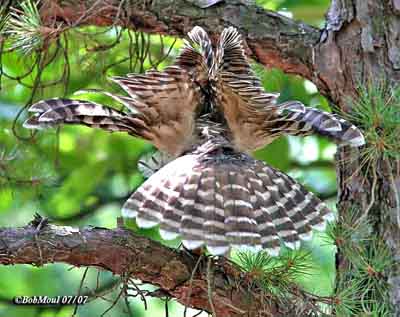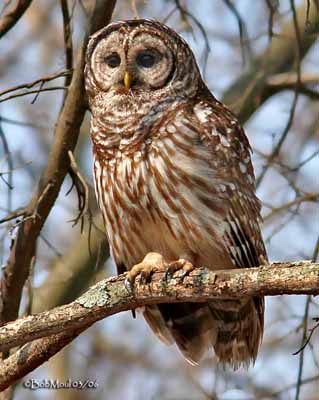
Barred Owl
Strix varia
Strigiforme Order – Strigidae Family
BIOMETRICS:
Length: M : 48 cm – F : 51 cm
Wingspan: 107-111 cm
Weight: M: 630 g – F: 800 g
DESCRIPTION:
The first description of this large owl was made by Benjamin Smith Barton, an amateur naturalist, in 1799.
Barred Owl has brown to grey-brown plumage. Most of upperparts, crown, neck and breast are horizontally and finely barred buff-white. On the wings, primaries and secondaries are barred too. Back is brown spotted white. The dark brown tail is fairly long and sharply barred pale brown.
PROTECTION / THREATS / STATUS:
Barred Owls have some predators, such as raccoons and weasels, eating eggs and nestlings.
Adults may be killed by Great-Horned Owl and Northern Goshawk, and collisions by vehicles. Deforestation may threaten the owls which need old trees for nesting, and in some parts of the range, the species has suffered degradation and habitat loss.
However, Barred Owl has successfully expanded its range, some decades ago, into north-western of North America where forested and riparian habitats have been successfully colonized.
Fr: Chouette rayée
All: Streifenkauz
Esp: Cárabo Norteamericano
Ital : Allocco barrato
Nd : Gestreepte Bosuil
Russe : Неясыть полосатая
Sd : Kråsuggla
Photographers:
Tom Grey
Tom Grey's Bird Pictures
René Lortie
http://rlortie.ca
Bob Moul
Nature Photography
Text by Nicole Bouglouan
Sources:
HANDBOOK OF THE BIRDS OF THE WORLD Vol 5 by Josep del Hoyo-Andrew Elliott-Jordi Sargatal - Lynx Edicions - ISBN: 8487334253
FIELD GUIDE TO THE BIRDS OF NORTH AMERICA - National Geographic Society - ISBN: 0792274512
A GUIDE TO THE BIRDS OF MEXICO AND NORTHERN CENTRAL AMERICA by Steve N. G. Howell, Sophie Webb - Oxford University Press - ISBN: 0198540124
Animal Diversity Web (University of Michigan Museum of Zoology)
What Bird-The ultimate Bird Guide (Mitchell Waite)
Wikipedia (Wikipedia, The Free Encyclopedia)

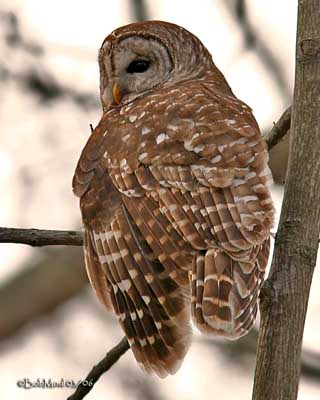
On the underparts, belly and flanks are buff-white with vertical, broad, dark brown barring, narrower on undertail coverts.
Some Barred Owls have pink belly feathers, due to eating a lot of crayfish.

Barred Owl has rather large, rounded head, without ear tufts. It has two grey-white to pale buffy-grey facial disks, with neat dark brown border and several dark concentric rings.
Eyes are brown, while most owls have yellow eyes.
Bill is yellow, partially covered with bristles. It is sharp, but small.
Legs and feet are feathered buff-white slightly barred and spotted brown, and talons are dark horn and black.
Both sexes are similar in plumage, but female is larger than male.
Juvenile has red-brown plumage, with buff barring on hind neck, and more pale buff on the underparts and on the barring of wings and tail.
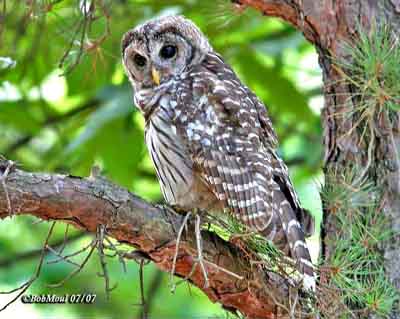
We can find 4 subspecies, “varia”, “helveola”, “georgica” and “sartorii”, which differ in intensity of colours and amount of barring and spotting.
VOICE: SOUNDS BY XENO-CANTO
Barred Owl is a very vocal species. It has distinctive call, a series of loud, far carrying, two-phased hoots “who-cook-for-you, who-cook-for-you-all”, and also a “hoo-ah”, and series of several barks rising in volume with loud disyllabic hoot at the end.
Mates utter typical calls such as mewing, making duets “hoo-hoo, hoo-WAAAHH”.
We can also hear shrieks, cries, trills, grumbles and squeaks.
Calls often include series of 8, then silence, listening for replies from other owls.

HABITAT:
Barred Owl is common in dense coniferous and mixed forests near water source, mature woodland near open country, deep moist forests, swamps, low meadows, stream side woodlands and wooded areas bordering lakes, and large parks with old trees.
This species may be seen from sea-level up to 1500-2500 metres of elevation in Mexico.
RANGE:
Barred Owl is widespread in North America, overall in the eastern half of the continent, in the north-western of North America, and south to Mexico. Northern birds may migrate, depending of food resources.
BEHAVIOUR:
To hunt, Barred Owl uses a perch from which it swoops on its prey. Main preys are small rodents, but also other mammals and birds.
Birds are taken while they are settled in their nocturnal roosts, because Barred Owl cannot catch them on the wing. They may also swoop down to the water’s edge to snatch some amphibians with the talons, and then, dragging the prey to the shore. It also forages for large insects attracted by campfires.
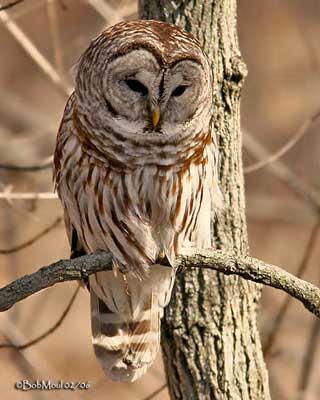
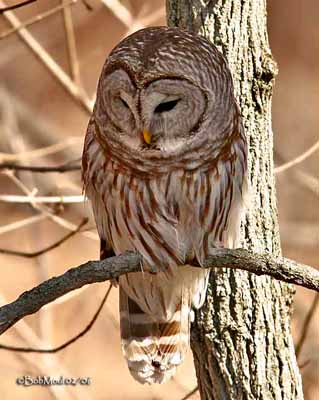
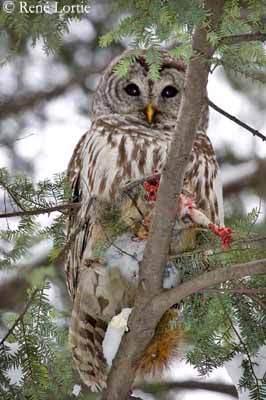
It grabs the preys with the talons. It may cache preys among tree branches and in nests. It is also able to catch bats in flight, but only occasionally.
Barred Owl eats the prey on the spot, but it carries the larger preys to a perch and tears apart before eating. They eat fur and bones, so, they regurgitate pellets which we can find under its favourite perches.
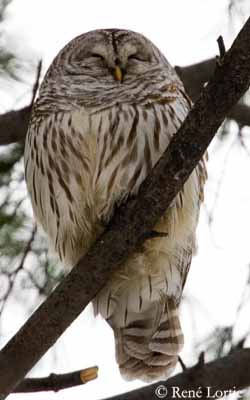
Barred Owl is solitary for most of the year, only living in family groups during breeding season until young fledge.
It is a nocturnal bird, often seen at dawn and dusk, but it can be seen during the day. This species needs trees with dense foliage for roosting by day, and large trees with potential nesting cavities.
It has special toes, with normally two forwards and two backwards. But it can turn a back toe forwards if it is necessary. That allows it to hold on to a perch.
Male and female stay together on the territory all year round. They reuse the same nest every year. They are thought to be monogamous, pairing for life.
Male and female perform courtship displays, vocalizing loudly. They will nod, bow with half-spread wings, and shake and twist their heads from side to side. Male chases after female and both mates display together, swaying back and forth, raising wings, and hovering near a branch.
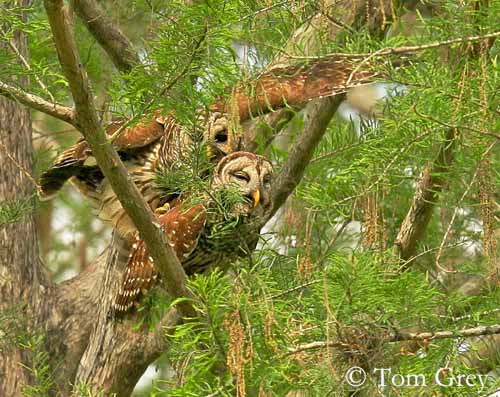
Barred Owl is mostly resident in its range. Only the northernmost populations may move according to the food resources.
FLIGHT:
Barred Owl flies with rapid wing beats, thanks to the special soft feathers, helping it to sneak up on night animals. But these feathers cannot catch the wind very well, and the owl has to work hard to fly.

REPRODUCTION:
Breeding season occurs between February and August, depending on the region.
Barred Owl nests in natural cavities, holes in tree trunks or branches. It does not build a nest, but it may add some soft materials such as feathers and fine grasses in the bottom. Sometimes, if any hole is available, it will use an old nest, abandoned by some hawk or crow.
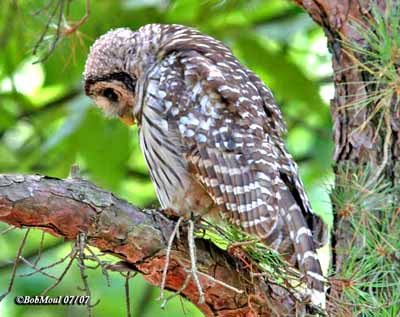
Female lays 2 to 3 almost round white eggs. Incubation lasts about 28 to 33 days, by female. She is fed by the male during this period.
Chicks hatch covered in white fluffy down, and they have closed eyes during one week. They can fledge at about 42 days of age, but before to fly, they crawl out of the nest and sit together, looking around them, near the nest. If they fall on the ground, they can climb back up with help of their beaks and claws. Parents feed them, tearing meat into small pieces.

When they are able to fly, they follow adults and learn to hunt.
They are fed by parents for long time, about up to six months, and they reach their sexual maturity at about two years.
This species produces one single brood per season.
DIET:
Barred Owls are carnivores. They can eat mice, squirrels, foxes, rabbits, bats, small birds, snakes, amphibians, lizards, fish, crayfish and bugs. Preys are usually swallowed whole, except for the large items.
